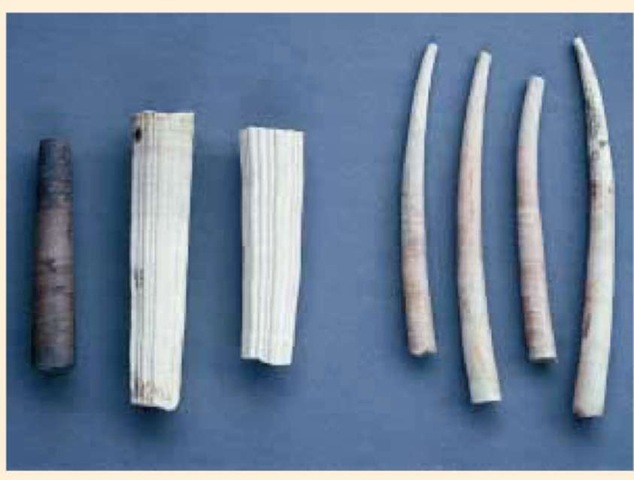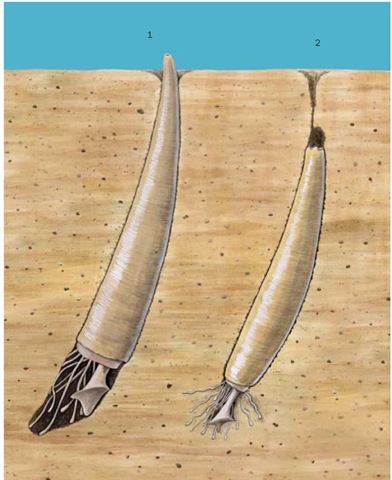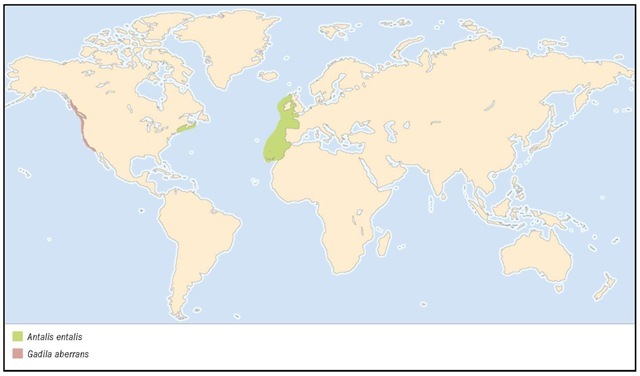Scaphopoda
(Tusk shells)
Phylum Mollusca
Number of families 14
Thumbnail description
Single-shelled tusk-shaped mollusks, ranging from about an eighth of an inch (a few mm) to 7.8 in (20 cm) in length. Burrow into exclusively marine sediments with a muscular foot; feed on microorganisms with thin tentacular captacula (threadlike cilia-bearing organs).
Photo: Three species of scaphopod mollusks. The dark colored specimen is Dentalium priseum, found in Carboniferous strata of Scotland. At center are specimens of D. sexangulare,from Miocene rocks in Tuscany, Italy. The tusklike shells, right, are of D. striatumfrom Eucene rocks in Hampshire, United Kingdom.

Evolution and systematics
Scaphopoda is the most recent class of mollusks to appear in the fossil record, dating from at least the Mississip-pian Carboniferous period about 360 million years ago (mya). Several earlier fossils, however, have been assigned to the Scaphopoda, but not without some debate as to their relationship to extant scaphopods. These earlier specimens date from the Devonian into the Ordovician period (about 450 mya). The earliest putative representatives cited are Plagioglypta iowensis and Rhytiodentalium kentuckyensis. The most recent classification system places scaphopods into two orders, Dentaliida and Gadilida. Within these orders, there are 14 families and 60 genera, 46 of which are extant.
There is little agreement on the relationship of scapho-pods to other mollusks. While scaphopods certainly belong among the uni- or bivalved mollusks in the subphylum Con-chifera, studies in the past several years have identified many different taxa as the closest scaphopod relative, including cephalopods, bivalves, gastropods, and the extinct class of bivalved mollusks known as Rostroconchia. Historically, this unclear picture has likely been the result of difficulties in comparing the morphology (form or structure) of scapho-pods to that of other mollusks. Recent molecular studies, however, have brought new evidence to bear on the problem. Expression of the engrailed gene in the early development of the scaphopod shell indicates an affinity with univalved cephalopods or gastropods rather than with bivalves. Moreover, 18S RNA sequence data indicate that scaphopods are most closely related to cephalopods among living mollusks.
Physical characteristics
Scaphopods get their name from the keel-shaped curvature of their shell. The shell is wider at the anterior end in most species, which explains the group’s common English name of tusk or tooth shell. In some scaphopods, the widest part of the shell is about one-third of the way back from the anterior opening. The shells of most scaphopods, which range from about an eighth of an inch to upwards of 7.8 in (20 cm) in length, are smooth or have faint circumferential growth lines. Some species have longitudinal or annular (ringlike) ribbing. Generally, the shell is white, but a few scaphopod species have strongly colored shells that are green or banded in red and yellow. In species with thin translucent shells, the pink or yellow color of the gonads (eggs) may show through.
A muscular foot and numerous thin feeding tentacles, or captacula, extend from the front opening of a typical scapho-pod. The narrower posterior end of the animal is also open, providing access to the mantle cavity for respiratory currents and the outflow of gametes and waste products. A small siphon-like extension of the mantle edge extends to and sometimes slightly beyond the posterior opening. The mantle cavity extends the length of the shell, partially encircling the body but otherwise quite narrow in its dorsoventral dimension. The restricted space has led to the loss of gills and the osphradium (chemosensory organ), which are structures found in the mantle cavity of most other mollusks. In turn, the loss of gills in scaphopods is reflected in the absence of auricles in the heart; in addition, the ventricle is much reduced.
Distribution
Scaphopods are found worldwide throughout the marine environment but not in brackish or estuarine systems. In terms of bathymetric distribution, they have been found from the intertidal zone in Australia to depths of about 23,000 ft (7,000 m) in the Sunda Trench, and are generally considered to be relatively well represented in deep-sea benthic (seabed) communities. Latitudinal distribution is similarly broad; scaphopods have been discovered well within both the Arctic and Antarctic Circles, and are found throughout temperate and tropical waters. While researchers have just begun to study the global distributional patterns of scaphopods, they know that the diversity of these animals in the Indo-Pacific region is relatively high, mirroring the distribution of diversity of many other marine taxa.
Habitat
Scaphopods are found exclusively in soft silty marine sediments, into which they burrow in search of food. Some species burrow only a short distance into the mud, leaving their narrow apical end protruding from the sediment surface; this position has become a classic illustration in many treatments of the group. Many species, such as Gadila aber-rans, however, burrow to depths several times their body length.
While most species favor foraminiferans as food, and thereby have a preference for habitats with high densities of these shelled protists, some species successfully inhabit other areas by broadening the variety of microorganisms they eat. While scaphopods are considered relatively uncommon members of the benthic communities in which they live, in some areas they can reach relatively high densities. For example, Rhabdus rectius reaches almost 60 individuals per square yard (0.76 square meter) around Sandford Island off the western coast of Vancouver Island, British Columbia.
Behavior
While all scaphopods burrow into soft sediments, some species may not dig deeply enough to completely cover the apical shell, which protrudes slightly from the seafloor surface. This behavior occurs naturally in at least some of the larger dentaliids, although it is also an artifact of laboratory observation that led to text topic overgeneralizations about the group over the years. In contrast, some gadilids have been reported to burrow quickly and go much deeper into the seabed, as far as 16 in (40 cm) at rates of 0.40 in/sec (1 cm/sec).
Scaphopods test the respiratory currents entering the mantle cavity with sensory receptors located around the mantle edge. If the current is fouled, the animal usually makes an escape response of deeper burrowing or withdrawal of the foot into the shell.
Feeding ecology and diet
Scaphopods feed on microorganisms, their diet dominated to a greater or lesser extent by foraminiferans. Some species, however, also feed on mite and other eggs; kinorhynchs (microscopic marine invertebrates); ostracods (tiny crustaceans); and bivalves. As such, they can be considered microcarni-vores or microomnivores. They select their prey by using thin, ciliated muscular tentacles called captacula, which have an adhesive gland complex in their tip that can transport food items to the mouth inside the shell. Depending on the species, the tentacles either extend out through the sediment or search the wall of a feeding cavity created by the scapho-pod’s foot. Foraminiferans have a shell or test, and scaphopods deal with these protective structures by crushing food items with their relatively large radula, a ribbon of teeth found in most mollusks. The scaphopod radula is short, stout, and heavily mineralized with iron. Food passes into the stomach and through a U-shaped gut; feces are released into the mantle cavity and discharged through the posterior aperture.
Scaphopods are preyed upon by all marine organisms that plow the sea floor mud for food. Their predators include such fishes as the ratfish. Naticid snails also feed on scaphopods, leaving behind the beveled bore-hole as the characteristic evidence of their predation.
Reproductive biology
Hermaphroditic scaphopods have been reported but are rare. Most members of the group release their eggs or sperm into the water column, either through the anterior or posterior aperture via the right kidney. Fertilization therefore occurs externally in the water; there is no courtship behavior or parental care of young. Few studies have been published on the reproductive ecology of scaphopods, although these do indicate some seasonality in gamete production. The eggs of scaphopods, particularly those of Antalis entalis and related species, have been used for over a century as models for the experimental study of early development of embryos.
Scaphopods have a free-swimming larval stage that develops in the water. The larvae have a general resemblance to the trochophore and veliger larvae of other mollusks. The orientation of the larval body eventually changes into the typical scaphopod body shape. It is noteworthy that the first shell secreted by the scaphopod, the larval praetubulus, is soon shed as growth continues at the larger anterior end of the animal— a pattern of shell secretion and dissolution that continues throughout the scaphopod’s life.
Conservation status
Little is known about the conservation status of scaphopods. With presumably wide-ranging but ill-defined distributions of individual species, there are few instances where population estimates can be made, and where monitoring of those populations can have significant consequences for conservation measures. As members of shallow water marine ecosystems, scaphopods are usually only a small component of local diversity, and so are not the focus of key-species studies. No species is listed by the IUCN.
Significance to humans
Scaphopods were important to Native Americans of the Pacific Northwest. Their use as a form of currency extended well into central Canada and south to California, despite only a few source sites on the west coast of Vancouver Island, where collection was difficult. Accounts of early European travelers indicate that the value of blankets could be measured in scaphopod shells. Naturally the shells were worn as displays of wealth, as can be seen in photographs by Edward Curtis as well as in the displays at such museums as the Museum of Anthropology at the University of British Columbia in Vancouver, the Royal British Columbia Museum in Victoria, and the Field Museum in Chicago. As of 2003, scaphopod shells are frequently sold in shell shops and often made into jewelry.

1. Tusk shell (Antalis entalis); 2. Aberrant tooth shell (Gadila aberrans).
Species accounts
Tusk shell
Antalis entalis
ORDER
Dentaliida
FAMILY
Dentaliidae
TAXONOMY
Dentalium entale Linnaeus, 1758, European, Indian Oceans.
OTHER COMMON NAMES
English: Entale tusk.
PHYSICAL CHARACTERISTICS
Smooth white shell, sometimes with faint longitudinal ribs toward the apex. Can reach an inch or more (several centimeters) in length, with the maximum diameter at the anterior opening. The posterior opening often has a shallow notch on its concave side.
DISTRIBUTION
Northeastern Atlantic from Ireland to the Canary Islands; one subspecies, A. entalis stimpsoni, is found in the northwestern Atlantic from Nova Scotia to Cape Cod.
HABITAT
Soft sediments at depths of several feet to about 6,600 ft (2,000 m).
BEHAVIOR
Often depicted with posterior opening protruding from the sediment surface.
FEEDING ECOLOGY AND DIET
Microomnivorous but prefers foraminiferans.
REPRODUCTIVE BIOLOGY
Sexes are separate; eggs and sperm are released into the water column for fertilization and development. Used as a model organism for studies of experimental embryology.
CONSERVATION STATUS
Not threatened.
SIGNIFICANCE TO HUMANS
None known.
Aberrant tooth shell
Gadila aberrans
ORDER
Gadilida
FAMILY
Gadilidae
TAXONOMY
Cadulus aberrans Whiteaves, 1887, Quatsino Sound, Vancouver Island, British Columbia, Canada.

OTHER COMMON NAMES
None known.
PHYSICAL CHARACTERISTICS
Smooth translucent shell, white or cream in color. Grows as long as 0.8 in (2 cm). Maximum diameter near anterior opening, which is slightly constricted; posterior opening often has four notches.
DISTRIBUTION
Northeastern Pacific Ocean from British Columbia to southern California.
HABITAT
Soft sediments at depths of 10-165 ft (3-50 m).
BEHAVIOR
Usually burrows several body lengths beneath the sediment surface.
FEEDING ECOLOGY AND DIET
Microcarnivorous, but prefers foraminiferans.
REPRODUCTIVE BIOLOGY
Sexes are separate; eggs and sperm are spawned into the water column where fertilization and development occur.
CONSERVATION STATUS
Not threatened.
SIGNIFICANCE TO HUMANS
None known.
